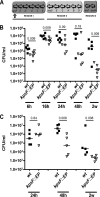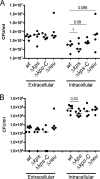Polysaccharide capsule and sialic acid-mediated regulation promote biofilm-like intracellular bacterial communities during cystitis
- PMID: 20086090
- PMCID: PMC2825929
- DOI: 10.1128/IAI.00925-09
Polysaccharide capsule and sialic acid-mediated regulation promote biofilm-like intracellular bacterial communities during cystitis
Abstract
Uropathogenic Escherichia coli (UPEC) is the leading cause of urinary tract infections (UTIs). A murine UTI model has revealed an infection cascade whereby UPEC undergoes cycles of invasion of the bladder epithelium, intracellular proliferation in polysaccharide-containing biofilm-like masses called intracellular bacterial communities (IBC), and then dispersal into the bladder lumen to initiate further rounds of epithelial colonization and invasion. We predicted that the UPEC K1 polysaccharide capsule is a key constituent of the IBC matrix. Compared to prototypic E. coli K1 strain UTI89, a capsule assembly mutant had a fitness defect in functionally TLR4(+) and TLR4(-) mice, suggesting a protective role of capsule in inflamed and noninflamed hosts. K1 capsule assembly and synthesis mutants had dramatically reduced IBC formation, demonstrating the common requirement for K1 polysaccharide in IBC development. The capsule assembly mutant appeared dispersed in the cytoplasm of the bladder epithelial cells and failed to undergo high-density intracellular replication during later stages of infection, when the wild-type strain continued to form serial generations of IBC. Deletion of the sialic acid regulator gene nanR partially restored IBC formation in the capsule assembly mutant. These data suggest that capsule is necessary for efficient IBC formation and that aberrant sialic acid accumulation, resulting from disruption of K1 capsule assembly, produces a NanR-mediated defect in intracellular proliferation and IBC development. Together, these data demonstrate the complex but important roles of UPEC polysaccharide encapsulation and sialic acid signaling in multiple stages of UTI pathogenesis.
Figures








Similar articles
-
Revisiting the Escherichia coli polysaccharide capsule as a virulence factor during urinary tract infection: contribution to intracellular biofilm development.Virulence. 2010 Jul-Aug;1(4):333-7. doi: 10.4161/viru.1.4.12388. Virulence. 2010. PMID: 21178466
-
Metabolic Requirements of Escherichia coli in Intracellular Bacterial Communities during Urinary Tract Infection Pathogenesis.mBio. 2016 Apr 12;7(2):e00104-16. doi: 10.1128/mBio.00104-16. mBio. 2016. PMID: 27073089 Free PMC article.
-
Population dynamics and niche distribution of uropathogenic Escherichia coli during acute and chronic urinary tract infection.Infect Immun. 2011 Oct;79(10):4250-9. doi: 10.1128/IAI.05339-11. Epub 2011 Aug 1. Infect Immun. 2011. PMID: 21807904 Free PMC article.
-
3-(2,6-difluorobenzamido)-5-(4-ethoxyphenyl) thiophene-2-carboxylic acid inhibits E.coli UT189 bacterial capsule biogenesis.2012 Apr 16 [updated 2013 Mar 14]. In: Probe Reports from the NIH Molecular Libraries Program [Internet]. Bethesda (MD): National Center for Biotechnology Information (US); 2010–. 2012 Apr 16 [updated 2013 Mar 14]. In: Probe Reports from the NIH Molecular Libraries Program [Internet]. Bethesda (MD): National Center for Biotechnology Information (US); 2010–. PMID: 23762949 Free Books & Documents. Review.
-
N-(pyridin-4-yl)benzo[d]thiazole-6-carboxamide inhibits E. coli UT189 bacterial capsule biogenesis.2012 Dec 17 [updated 2013 Apr 5]. In: Probe Reports from the NIH Molecular Libraries Program [Internet]. Bethesda (MD): National Center for Biotechnology Information (US); 2010–. 2012 Dec 17 [updated 2013 Apr 5]. In: Probe Reports from the NIH Molecular Libraries Program [Internet]. Bethesda (MD): National Center for Biotechnology Information (US); 2010–. PMID: 23833802 Free Books & Documents. Review.
Cited by
-
Lipopolysaccharide Domains Modulate Urovirulence.Infect Immun. 2016 Oct 17;84(11):3131-3140. doi: 10.1128/IAI.00315-16. Print 2016 Nov. Infect Immun. 2016. PMID: 27528276 Free PMC article.
-
Recurrent urinary tract infections in healthy and nonpregnant women.Urol Sci. 2014 Mar;25(1):1-8. doi: 10.1016/j.urols.2013.11.007. Urol Sci. 2014. PMID: 27499825 Free PMC article.
-
The role of major virulence factors and pathogenicity of adherent-invasive Escherichia coli in patients with Crohn's disease.Prz Gastroenterol. 2020;15(4):279-288. doi: 10.5114/pg.2020.93235. Epub 2020 Dec 10. Prz Gastroenterol. 2020. PMID: 33777266 Free PMC article. Review.
-
Evolutionary and functional history of the Escherichia coli K1 capsule.Nat Commun. 2023 Jun 15;14(1):3294. doi: 10.1038/s41467-023-39052-w. Nat Commun. 2023. PMID: 37322051 Free PMC article.
-
Regulation of Escherichia coli Group 2 Capsule Gene Expression: A Mini Review and Update.Front Microbiol. 2022 Mar 10;13:858767. doi: 10.3389/fmicb.2022.858767. eCollection 2022. Front Microbiol. 2022. PMID: 35359738 Free PMC article. Review.
References
-
- Anderson, G. G., J. J. Palermo, J. D. Schilling, R. Roth, J. Heuser, and S. J. Hultgren. 2003. Intracellular bacterial biofilm-like pods in urinary tract infections. Science 301:105-107. - PubMed
-
- Anderson, J. B., F. Parivar, G. Lee, T. B. Wallington, A. G. MacIver, R. A. Bradbrook, and J. C. Gingell. 1989. The enigma of interstitial cystitis—an autoimmune disease? Br. J. Urol. 63:58-63. - PubMed
-
- Aoki, S. K., R. Pamma, A. D. Hernday, J. E. Bickham, B. A. Braaten, and D. A. Low. 2005. Contact-dependent inhibition of growth in Escherichia coli. Science 309:1245-1248. - PubMed
Publication types
MeSH terms
Substances
Grants and funding
LinkOut - more resources
Full Text Sources
Other Literature Sources

